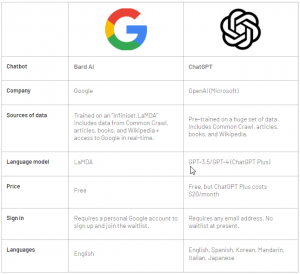Bard: Difference between revisions
PauloPacheco (talk | contribs) (Created page with "Bard is a conversational AI chatbot developed by Google, trained on a vast dataset of text and code to generate human-like responses to user inputs. It is a large language model (LLM) like OpenAI's ChatGPT. <ref name="”1”">[1] Fedewa, J (2023). What Is Google Bard? Hands-on With the AI Chatbot. How-to Geek. https://www.howtogeek.com/880598/what-is-google-bard/</ref> As a generative AI, it accepts prompts and performs text-based tasks such as answe...") |
(No difference)
|
Revision as of 15:19, 26 April 2023
Bard is a conversational AI chatbot developed by Google, trained on a vast dataset of text and code to generate human-like responses to user inputs. It is a large language model (LLM) like OpenAI's ChatGPT. [1] As a generative AI, it accepts prompts and performs text-based tasks such as answering questions, summarizing information, and creating various forms of content. Google's Bard can assist users in exploring topics by providing summaries of internet-sourced information and links to relevant websites. [2] It can also be used to boost productivity, increase creativity, and satisfy curiosity by offering tips, simplifying complex concepts, or outlining blog posts. [3] According to Google, Bard's goal is to combine the world's knowledge with a powerful language model, offering fresh, high-quality responses and serving as a creative outlet and a launchpad for curiosity, helping users learn about various topics. [4]
While the AI chatbot trend started with ChatGPT and was followed by Microsoft's Bing Chat, Google Bard entered the market later but it has the support of the most popular search engine. Google has been cautious in releasing Bard, deploying it as a separate service from its search engine and other products to manage potential unexpected behavior. [1] After the launch of OpenAI's ChatGPT, the technology was perceived as revolutionary and disruptive to the search industry, and contributed to the impression that Google was technologically lagging, which prompted the release of Bard. [2]
How does it work
The use of machine learning is essential for the training process of AI chatbots like Bard. It analyzes text and predicts the next word based on what it has learned, basically functioning as a sophisticated predictive text engine. [1][5] Bard uses a lightweight and optimized version of Google's LaMDA (Language Model for Dialogue Applications), requiring less computing power and allowing for scaling to more users and receiving valuable feedback. This model is responsible for generating human-like responses, utilizing information from the web. [1][2][3][4]
In the research paper, "LaMDA: Language Models for Dialog Applications", Thoppilan et al. (2022) establish two ssential factors related to LaMDA's training: safety and froundedness. The first is achieved by tunin the model with data annotated by crowd workers, while the second is attained through external knowledge sources using information retrieval techniques. [3][6] Google also evaluates LaMDA outputs based on three metrics: sensibleness, specificity, and interestingness, all of which are assessed by crowdsourced raters whose feedback is used to improve the model. According to Thoppilan et al. (2022), the use of crowdsourced reviews and the "system's ability to fact-check with a search engine" proved to be valuable techniques in refining the model. [2][6]
Development
While LaMDA had been in development internally, Bard was only announced on February 6th, 2023, after CEO Sundar Pichai reassigned various teams to increase Goggle's AI development. A waitlist to use it opened on March 21st. After its first public demonstration, Google's stock feel by eight percent due to the demo containing a factual error. This was an indication of the loss of confidence in Google's ability to enter the new era of AI. [2][7]
While there hasn't been an official explanatin for the name "Bard," it is "assumed to be a reference to the word that means “poet.” Poets have a way with words, and Google is implying Bard does as well." [1]
Basic features
Google Bard has a simple interface where users input prompts through typing or voice (figure 1). [8] The response is not generated in real-time like ChatGPT and Bing Chat. Instead, it presents the full response after loading (figure 2). Users can rate responses with a thumbs up or down, regenerate them, or do a Google Search. Bard's "drafts" feature provides alternative responses to user prompts. Since the chatbot is conversational, it maintains context for follow-up prompts. However, unlike ChatGPT, Bard cannot save or share conversations. Regarding sources, not always does it cites them. [1]
Characteristics
Users have reported that Google Bard excels in areas like basic math calculations and provides recent or local information but it may struggle with logical reasoning tests. [5] It acknowledges its limitations, the potential for mistakes, and like other tools based on large language models, it can be biased, which results from its internet-based training. [5][7]
Being and experimental system, it's designed for casual use. It generates new responses for every prompt, annotates some answers for source review, and is cautious in providing questions about specific people or providing medical, legal, or financial advice. [7]
Bard combines features from LLMs like LaMDA with search engine technology to improve its reliability, providing more accurate and up-to-date information. [2][7] However, Google describes this system as a complement to search, not a replacement for the complany's search engine, and it still doesn't enhance any Google products. [5][9]
Bard vs ChatGPT and Bing Chat
Bard vs ChatGPT
The main difference between Bard and ChatGPT is their data sources, with Bard using LaMDA and access to real-time internet data, while ChatGPT relies on GPT-3 or GPT-4 models trained on pre-2021 data. [10][11] The ability to draw real-time data enables it to provide more current information. [11] A full list of differences can be viewed in figure 3.
ChatGPT excels in coding prompts and conversational learning, while Bard lags in these two aspects but offers multiple response drafts for queries. Nevertheless, Bard's answers tend to be more conversational and formatted in a more readable way, whereas ChatGPT's responses are more informational. Also ChatGPT is better at paraphrasing and summarizing. [10]
Finally, regarding user experience, Bard outperforms ChatGPT with its user-friendly interface, easier-to-scan formatted text, and the ability to edit questions. Google's chatbot also enables users to view multiple prepared responses. [1][10][11]
Bard vs Bing Chat
Bing Chat, based on OpenAI's ChatGPT, incorporates Microsoft's Prometheus platform to connect with the search engine, enabling faster and more accurate responses. In contrast, Bard focuses on answering questions directly without directly integrating a search engine component. Both systems save search intent in users' search histories, but do not collect questions typed in the prompt box. [12]
Bing Chat seems to surpass Bard feature-wise, offering citations in responses and the option to change conversational tone. Bing Chat also integrates with OpenAI's DALL-E, while Google Bard lacks this capability. Bing Chat enables users to share a persistent link to a specific answer, whereas Google Bard does not. [12]
Google Bard can be accessed via any web browser on desktop or mobile devices, while Bing Chat requires Microsoft Edge or the Bing mobile app. [12]
Future
It is expected that, in the future, Bard will be a feature in search. However, Goggle hasn't confirmed how it will be implemented, just mentioning in the announcement blog of its AI tool that it was an AI feature in search. According to Google, "Soon, you’ll see AI-powered features in Search that distill complex information and multiple perspectives into easy-to-digest formats, so you can quickly understand the big picture and learn more from the web: whether that’s seeking out additional perspectives, like blogs from people who play both piano and guitar, or going deeper on a related topic, like steps to get started as a beginner.” [2]
References
- ↑ 1.0 1.1 1.2 1.3 1.4 1.5 1.6 [1] Fedewa, J (2023). What Is Google Bard? Hands-on With the AI Chatbot. How-to Geek. https://www.howtogeek.com/880598/what-is-google-bard/
- ↑ 2.0 2.1 2.2 2.3 2.4 2.5 2.6 Montti, R (2023). Google Bard: Everything You Need To Know. Search Engine Journal. https://www.searchenginejournal.com/google-bard/482860/
- ↑ 3.0 3.1 3.2 Hsiao, S and Collins, E (2023). Try Bard and Share Your Feedback. Google. https://blog.google/technology/ai/try-bard/
- ↑ 4.0 4.1 Pichai, S (2023). An Important Next Step on Our AI Journey. Google. https://blog.google/technology/ai/bard-google-ai-search-updates/
- ↑ 5.0 5.1 5.2 5.3 Fowler, GA (2023). Say what, Bard? What Google’s New AI Gets Right, Wrong and Weird. The Washington Post. https://www.washingtonpost.com/technology/2023/03/21/google-bard/
- ↑ 6.0 6.1 Thoppilan, R, de Freitas, D, Hall, J, Shazeer, N, Kulshreshtha, A, Cheng, H-T, Jin, A, Bos, T, Baker, L, Du, Y, Li, Y, Lee, H, Zheng, HS, Ghafouri, A, Menegali, M, Huang, Y, Krikun, M, Lepikhin, D, Qin, J, Chen, D, Xu, Y, Chen, Z, Roberts, A, Bosma, M, Zhao, V, Zhou, Y, Chang, C-C, Krivokon, I, Rusch, W, Pickett, M, Srinivasan, P, Man, L, Meier-Hellstern, K, Morris, MR, Doshi, T, Santos, RD, Duke, T, Soraker, J, Zevenbergen, B, Prabhakaran, V, Diaz, M, Hutchinson, B, Olson, K, Molina, A, Hoffman-John, E, Lee, J, Aroyo, L, Rajakumar, R, Butryna, A, Lamm, M, Kuzmina, V, Fenton, J, Cohen, A, Bernstein, R, Kurzweil, R, Aguera-Arcas, B, Cui, C, Croak, M., Chi, E and Le, Q (2022). LaMDA: Language Models for Dialog Applications. arXiv:2201.08239v3. https://arxiv.org/pdf/2201.08239.pdf
- ↑ 7.0 7.1 7.2 7.3 Metz, C (2023).What Google Bard Can Do (and What It Can’t).The New York Times. https://www.nytimes.com/2023/03/21/technology/google-bard-guide-test.html
- ↑ Hoffman, C (2923). Google Bard: How to Use Google’s AI Chatbot. Hot-to Geek. https://www.howtogeek.com/880668/google-bard-how-to-use-googles-ai-chatbot
- ↑ Pierce, D (2023). Google Says its Bard Chatbot Isn’t a Search Engine — So What is It? The Verge. https://www.theverge.com/23649897/google-bard-chatbot-search-engine
- ↑ 10.0 10.1 10.2 Drapkin, A (2023). Google Bard vs ChatGPT: Which Is the Best AI Chatbot? Tech.co. https://tech.co/news/google-bard-vs-chatgpt
- ↑ 11.0 11.1 11.2 Alston, E (2023). ChatGPT vs. Bard: What's The Difference? Zapier. https://zapier.com/blog/chatgpt-vs-bard/
- ↑ 12.0 12.1 12.2 Huc, M (2023). Bing Chat vs. Google Bard: How do these AI chatbots differ?. Pureinfotech. https://pureinfotech.com/bing-chat-vs-google-bard-ai-chatbots-differ/




